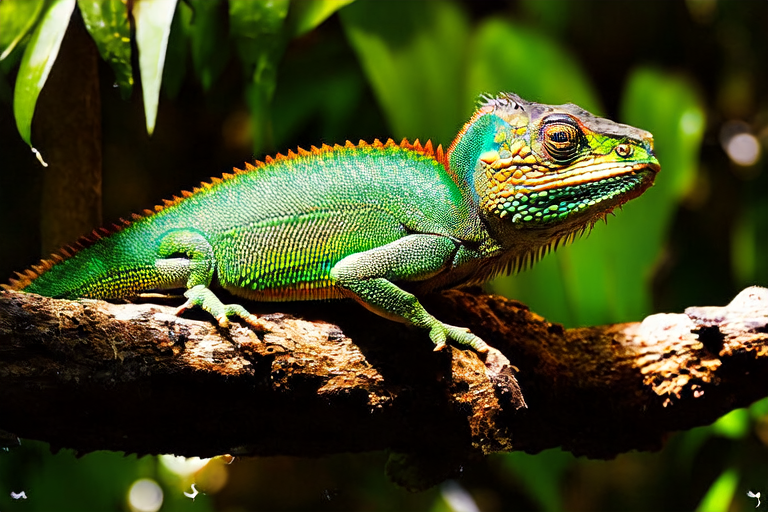The Science Behind Chameleon Color Changes
Chameleons have long been the subject of fascination and awe, known for their remarkable ability to change color. This phenomenon, while often associated with blending into the environment, is far more complex than merely mimicking surroundings. The mechanisms behind chameleon color changes involve intricate physiological processes, influenced by various environmental factors, and offer significant evolutionary advantages. Understanding these changes provides insights into how these creatures communicate, defend themselves, and regulate their body temperature.
Physiological Mechanisms
The primary mechanism responsible for chameleon color changes lies within specialized cells called chromatophores located beneath their skin. These cells contain pigments that can expand or contract, altering the visible color of the chameleon. Three types of chromatophores contribute to this process:
- Xanthophores: Contain yellow pigments.
- Erythrophores: Contain red pigments.
- Iridophores: Reflect light, creating structural colors like blue and green.
Chromatophores are arranged in layers, with iridophores on top, followed by xanthophores and erythrophores. When a chameleon wants to change its color, it sends signals through neurons and hormones, causing specific chromatophores to expand or contract. This process allows chameleons to display a wide range of colors, from bright greens and blues to deep reds and blacks.
Environmental Influences
Several environmental factors influence chameleon color changes, including lighting, temperature, and humidity. For instance, chameleons may change color when exposed to different light spectrums, as certain wavelengths can trigger pigment expansion or contraction. Temperature also plays a crucial role; chameleons may darken to absorb more heat or lighten to reflect sunlight and cool down. Humidity affects hydration levels, which in turn influences coloration.
Moreover, social interactions significantly impact color changes. Male chameleons often exhibit vibrant colors during territorial disputes or courtship displays, signaling dominance or readiness to mate. Females, on the other hand, may use color changes to indicate receptiveness or rejection of a male’s advances. Stressful situations can also induce rapid color shifts, serving as an early warning system.
Evolutionary Advantages
The ability to change color offers numerous evolutionary benefits for chameleons. One of the most well-known advantages is camouflage, enabling them to blend into their surroundings and avoid detection by predators or prey. For example, a chameleon resting on a tree branch might adopt a brown or green hue to match the bark or leaves, making it nearly invisible to potential threats.
Color changes also play a vital role in communication. Males use vivid colors to establish dominance over rivals or attract females. During mating season, males may engage in “color duels,” where they display their brightest hues to intimidate competitors. Females, in turn, use subtle color variations to signal their reproductive status. Additionally, chameleons may use color changes to convey distress or submission, reducing the likelihood of aggressive encounters.
Thermoregulation represents another important advantage. By adjusting their color, chameleons can control how much sunlight they absorb or reflect, helping them maintain optimal body temperatures. Darker colors absorb more heat, while lighter colors reflect sunlight, allowing chameleons to regulate their internal temperature without expending additional energy.
Common Misconceptions
Despite popular belief, chameleons do not primarily use their color-changing abilities for camouflage. While camouflage does occur, it is just one aspect of their broader repertoire of color changes. Another misconception involves the speed of color changes. Many people believe that chameleons can instantly shift colors, but the process typically takes several minutes. Furthermore, some assume that all chameleons can change color equally well, whereas certain species exhibit more limited color ranges or slower changes.
Recent Research Findings
Recent studies have shed new light on the complexities of chameleon color changes. Researchers have discovered that the reflective properties of iridophores are key to producing structural colors, which can change based on the angle of light. This finding explains why chameleons can display such a wide array of colors, even though they lack the pigments needed for those hues.
Another area of interest is the role of hormones in regulating color changes. Scientists have identified specific hormones that trigger pigment expansion or contraction, providing insights into how chameleons respond to environmental stimuli. Additionally, researchers are exploring the genetic basis of color-changing abilities, aiming to understand how these traits evolved and diversified across different chameleon species.
Recent advancements in imaging technology have allowed scientists to visualize the intricate structure of chromatophores in unprecedented detail. These images reveal the layered arrangement of cells and the precise mechanisms by which they expand or contract, offering valuable information about the physiology of color changes. Moreover, ongoing research focuses on the neural pathways involved in controlling color changes, shedding light on the complex interplay between brain function and physical appearance.
Conclusion
The science behind chameleon color changes encompasses a fascinating array of physiological mechanisms, environmental influences, and evolutionary advantages. From camouflage and communication to thermoregulation, these creatures rely on their unique abilities to thrive in diverse habitats. As research continues to unravel the mysteries of chameleon color changes, we gain a deeper appreciation for the complexity and beauty of nature. By understanding these processes, we can better protect chameleons and their ecosystems, ensuring that future generations can marvel at their captivating transformations.
